Template:Ipl exponential
IPL-Exponential
The IPL-exponential model can be derived by setting [math]\displaystyle{ m=L(V) }[/math] in Eqn. (inverse), yielding the following IPL-exponential [math]\displaystyle{ pdf }[/math] :
- [math]\displaystyle{ f(t,V)=K{{V}^{n}}{{e}^{-K{{V}^{n}}t}} }[/math]
Note that this is a 2-parameter model. The failure rate (the parameter of the exponential distribution) of the model is simply [math]\displaystyle{ \lambda =K{{V}^{n}}, }[/math] and is only a function of stress.
IPL-Exponential Statistical Properties Summary
Mean or MTTF
The mean, [math]\displaystyle{ \overline{T}, }[/math] or Mean Time To Failure (MTTF) for the IPL-exponential relationship is given by:
- [math]\displaystyle{ \begin{align} & \overline{T}= & \mathop{}_{0}^{\infty }t\cdot f(t,V)dt=\mathop{}_{0}^{\infty }t\cdot K{{V}^{n}}{{e}^{-K{{V}^{n}}t}}dt \\ & = & \frac{1}{K{{V}^{n}}} \end{align} }[/math]
Note that the MTTF is a function of stress only and is simply equal to the IPL relationship (which is the original assumption), when using the exponential distribution.
Median
The median, [math]\displaystyle{ \breve{T}, }[/math] for the IPL-exponential model is given by:
- [math]\displaystyle{ \breve{T}=0.693\frac{1}{K{{V}^{n}}} }[/math]
Mode
The mode, [math]\displaystyle{ \tilde{T}, }[/math] for the IPL-exponential model is given by:
- [math]\displaystyle{ \tilde{T}=0 }[/math]
Standard Deviation
The standard deviation, [math]\displaystyle{ {{\sigma }_{T}} }[/math] , for the IPL-exponential model is given by:
- [math]\displaystyle{ {{\sigma }_{T}}=\frac{1}{K{{V}^{n}}} }[/math]
IPL-Exponential Reliability Function
The IPL-exponential reliability function is given by:
- [math]\displaystyle{ R(T,V)={{e}^{-TK{{V}^{n}}}} }[/math]
This function is the complement of the IPL-exponential cumulative distribution function:
- [math]\displaystyle{ R(T,V)=1-Q(T,V)=1-\mathop{}_{0}^{T}f(T,V)dT }[/math]
- or:
- [math]\displaystyle{ R(T,V)=1-\mathop{}_{0}^{T}K{{V}^{n}}{{e}^{-K{{V}^{n}}T}}dT={{e}^{-K{{V}^{n}}T}} }[/math]
Conditional Reliability
The conditional reliability function for the IPL-exponential model is given by:
- [math]\displaystyle{ R(T,t,V)=\frac{R(T+t,V)}{R(T,V)}=\frac{{{e}^{-\lambda (T+t)}}}{{{e}^{-\lambda T}}}={{e}^{-K{{V}^{n}}t}} }[/math]
Reliable Life
For the IPL-exponential model, the reliable life or the mission duration for a desired reliability goal, [math]\displaystyle{ {{t}_{R}}, }[/math] is given by:
- [math]\displaystyle{ R({{t}_{R}},V)={{e}^{-K{{V}^{n}}{{t}_{R}}}} }[/math]
- [math]\displaystyle{ \ln [R({{t}_{R}},V)]=-K{{V}^{n}}{{t}_{R}} }[/math]
- or:
- [math]\displaystyle{ {{t}_{R}}=-\frac{1}{K{{V}^{n}}}\ln [R({{t}_{R}},V)] }[/math]
Parameter Estimation
Maximum Likelihood Parameter Estimation
Substituting the inverse power law relationship into the exponential log-likelihood equation yields:
- [math]\displaystyle{ \begin{align} & \ln (L)= & \Lambda =\underset{i=1}{\overset{{{F}_{e}}}{\mathop \sum }}\,{{N}_{i}}\ln \left[ KV_{i}^{n}{{e}^{-KV_{i}^{n}{{T}_{i}}}} \right] \\ & & -\underset{i=1}{\overset{S}{\mathop \sum }}\,N_{i}^{\prime }KV_{i}^{n}T_{i}^{\prime }+\overset{FI}{\mathop{\underset{i=1}{\mathop{\underset{}{\overset{}{\mathop \sum }}\,}}\,}}\,N_{i}^{\prime \prime }\ln [R_{Li}^{\prime \prime }-R_{Ri}^{\prime \prime }] \end{align} }[/math]
- where:
- [math]\displaystyle{ R_{Li}^{\prime \prime }={{e}^{-T_{Li}^{\prime \prime }KV_{i}^{n}}} }[/math]
- [math]\displaystyle{ R_{Ri}^{\prime \prime }={{e}^{-T_{Ri}^{\prime \prime }KV_{i}^{n}}} }[/math]
- and:
• [math]\displaystyle{ {{F}_{e}} }[/math] is the number of groups of exact times-to-failure data points.
• [math]\displaystyle{ {{N}_{i}} }[/math] is the number of times-to-failure in the [math]\displaystyle{ {{i}^{th}} }[/math] time-to-failure data group.
• [math]\displaystyle{ {{V}_{i}} }[/math] is the stress level of the [math]\displaystyle{ {{i}^{th}} }[/math] group.
• [math]\displaystyle{ K }[/math] is the IPL parameter (unknown, the first of two parameters to be estimated).
• [math]\displaystyle{ n }[/math] is the second IPL parameter (unknown, the second of two parameters to be estimated).
• [math]\displaystyle{ {{T}_{i}} }[/math] is the exact failure time of the [math]\displaystyle{ {{i}^{th}} }[/math] group.
• [math]\displaystyle{ S }[/math] is the number of groups of suspension data points.
• [math]\displaystyle{ N_{i}^{\prime } }[/math] is the number of suspensions in the [math]\displaystyle{ {{i}^{th}} }[/math] group of suspension data points.
• [math]\displaystyle{ T_{i}^{\prime } }[/math] is the running time of the [math]\displaystyle{ {{i}^{th}} }[/math] suspension data group.
• [math]\displaystyle{ FI }[/math] is the number of interval data groups.
• [math]\displaystyle{ N_{i}^{\prime \prime } }[/math] is the number of intervals in the i [math]\displaystyle{ ^{th} }[/math] group of data intervals.
• [math]\displaystyle{ T_{Li}^{\prime \prime } }[/math] is the beginning of the i [math]\displaystyle{ ^{th} }[/math] interval.
• [math]\displaystyle{ T_{Ri}^{\prime \prime } }[/math] is the ending of the i [math]\displaystyle{ ^{th} }[/math] interval.
The solution (parameter estimates) will be found by solving for the parameters [math]\displaystyle{ \widehat{K}, }[/math] [math]\displaystyle{ \widehat{n} }[/math] so that [math]\displaystyle{ \tfrac{\partial \Lambda }{\partial K}=0 }[/math] and [math]\displaystyle{ \tfrac{\partial \Lambda }{\partial n}=0 }[/math] , where:
- [math]\displaystyle{ \begin{align} & \frac{\partial \Lambda }{\partial K}= & \frac{1}{K}\underset{i=1}{\overset{{{F}_{e}}}{\mathop \sum }}\,{{N}_{i}}-\underset{i=1}{\overset{{{F}_{e}}}{\mathop \sum }}\,{{N}_{i}}V_{i}^{n}{{T}_{i}}-\underset{i=1}{\overset{S}{\mathop \sum }}\,N_{i}^{\prime }V_{i}^{n}T_{i}^{\prime } \\ & & \overset{FI}{\mathop{\underset{i=1}{\mathop{-\underset{}{\overset{}{\mathop \sum }}\,}}\,}}\,N_{i}^{\prime \prime }\frac{\left( T_{Li}^{\prime \prime }R_{Li}^{\prime \prime }-T_{Ri}^{\prime \prime }R_{Ri}^{\prime \prime } \right)V_{i}^{n}}{R_{Li}^{\prime \prime }-R_{Ri}^{\prime \prime }} \end{align} }[/math]
- [math]\displaystyle{ \begin{align} & \frac{\partial \Lambda }{\partial n}= & \underset{i=1}{\overset{{{F}_{e}}}{\mathop \sum }}\,{{N}_{i}}\ln ({{V}_{i}})-K\underset{i=1}{\overset{{{F}_{e}}}{\mathop \sum }}\,{{N}_{i}}V_{i}^{n}\ln ({{V}_{i}}){{T}_{i}} \\ & & -K\underset{i=1}{\overset{S}{\mathop \sum }}\,N_{i}^{\prime }V_{i}^{n}\ln ({{V}_{i}})T_{i}^{\prime } \\ & & \overset{FI}{\mathop{\underset{i=1}{\mathop{-\underset{}{\overset{}{\mathop \sum }}\,}}\,}}\,N_{i}^{\prime \prime }\frac{KV_{i}^{n}\ln ({{V}_{i}})\left( T_{Li}^{\prime \prime }R_{Li}^{\prime \prime }-T_{Ri}^{\prime \prime }R_{Ri}^{\prime \prime } \right)}{R_{Li}^{\prime \prime }-R_{Ri}^{\prime \prime }} \end{align} }[/math]
